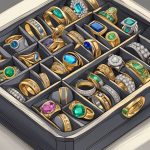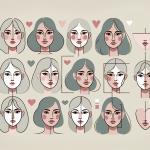Types Of Engagement Rings
Engagement rings are a symbol of commitment and love, making them an essential part of any wedding proposal. With so many different styles, settings, and diamond shapes available, choosing the right engagement ring can be a daunting task. However, understanding the different types of engagement rings can help you make an informed decision and find the perfect ring for your partner.
There are many different styles of engagement rings to choose from, each with its own unique characteristics. Some of the most popular styles include solitaire, halo, vintage, and three-stone rings. Solitaire rings are the most classic and traditional style, featuring a single diamond set in a simple band. Halo rings are a more modern style, featuring a center diamond surrounded by smaller diamonds or gemstones. Vintage rings are inspired by antique designs and often feature intricate details and unique shapes.
Choosing the right diamond is also an important part of finding the perfect engagement ring. The 4Cs of diamonds (cut, clarity, color, and carat weight) are used to determine a diamond’s quality and value. The cut of the diamond refers to its proportions and how well it reflects light, while the clarity refers to the absence of blemishes or inclusions. The color of the diamond can range from completely colorless to yellow or brown, and the carat weight refers to the size of the diamond.
Key Takeaways
- Understanding the different types of engagement rings can help you make an informed decision and find the perfect ring for your partner.
- Choosing the right diamond is an important part of finding the perfect engagement ring.
- Personalization and customization options can add a unique touch to your engagement ring while staying within your budget.
Understanding Engagement Ring Styles

When it comes to engagement rings, there are many different styles to choose from. Each style has its own unique characteristics that make it stand out. In this section, we will explore the classic styles, vintage appeal, and contemporary designs of engagement rings.
Classic Styles
Classic engagement rings are timeless and never go out of style. They typically feature a single diamond or gemstone set in a simple band. The most popular classic style is the solitaire ring, which has a single stone in the center. Other classic styles include three-stone rings, which have a larger center stone flanked by two smaller stones, and halo rings, which have a center stone surrounded by a halo of smaller diamonds or gemstones.
Vintage Appeal
Vintage engagement rings have a unique charm and appeal. They are often inspired by designs from the past and feature intricate details and ornate settings. Some popular vintage styles include Art Deco, which features geometric shapes and bold lines, and Victorian, which features intricate filigree and delicate details.
Contemporary Designs
Contemporary engagement rings are modern and often feature unique designs and non-traditional materials. Some popular contemporary styles include tension-set rings, which suspend the center stone between two ends of the band, and bezel-set rings, which have a metal rim that surrounds the center stone. Other contemporary styles include colored gemstones and asymmetrical designs.
Overall, there are many different types of engagement ring styles to choose from. Whether you prefer classic, vintage, or contemporary designs, there is a style out there that will suit your taste and personality.
Choosing the Right Diamond
When it comes to choosing the right diamond for an engagement ring, there are several factors to consider. The cut, color, clarity, carat weight, and quality of the diamond all play a role in determining its overall appearance and value.
Cut and Shape
The cut of a diamond refers to its proportions and how well it reflects light. A well-cut diamond will have maximum brilliance and fire, making it appear more sparkly and dazzling. The shape of a diamond is a matter of personal preference, with popular diamond shapes including round, princess, cushion, and pear.
Color and Clarity
The color of a diamond is graded on a scale from D (colorless) to Z (light yellow or brown). The less color a diamond has, the more valuable it is. Clarity refers to the number and size of imperfections, or inclusions, in a diamond. The fewer inclusions a diamond has, the more valuable it is.
Carat Weight and Quality
Carat weight refers to the size of a diamond, with larger diamonds being more valuable. However, it’s important to note that carat weight is not the only factor that determines a diamond’s value. Quality is also important, with high-quality diamonds having better cut, color, and clarity.
Overall, choosing the right diamond for an engagement ring requires careful consideration of all these factors. It’s important to set a budget and prioritize what’s most important to you, whether it’s size, quality, or a specific diamond shape. By doing so, you can ensure that you find the perfect diamond for your engagement ring.
Ring Settings and Mountings
When it comes to engagement rings, the setting or mounting is just as important as the diamond itself. A ring setting refers to the way the diamond or gemstone is secured in the ring. Below are some of the most popular ring settings and mountings.
Solitaire Setting
The solitaire setting is a classic and timeless choice for an engagement ring. It features a single diamond or gemstone set in a simple prong setting, allowing the stone to be the center of attention. This setting is perfect for those who prefer a minimalist look or want to showcase a larger diamond.
Halo and Accented
Halo and accented settings are perfect for those who want a little extra sparkle. A halo setting features a center diamond or gemstone surrounded by a halo of smaller diamonds or gemstones, while an accented setting features diamonds or gemstones set into the band of the ring. These settings can make a smaller center stone appear larger and add extra brilliance to the ring.
Three-Stone and Side Stone
Three-stone and side stone settings are a popular choice for those who want to add extra symbolism to their engagement ring. A three-stone setting features three diamonds or gemstones, with the center stone typically larger than the two side stones. Side stone settings feature diamonds or gemstones set into the band of the ring, usually in a channel or prong setting. These settings can add extra sparkle and significance to the ring.
Unique Settings
For those who want a truly unique engagement ring, there are a variety of alternative settings to choose from. Tension settings feature a diamond or gemstone held in place by the tension of the metal band, while cathedral settings feature arches of metal that support the center stone. Other unique settings include bezel settings, flush settings, and bar settings, each with their own distinct look and feel.
Overall, the ring setting and mounting you choose will depend on your personal style and preferences. Whether you prefer a classic solitaire or a unique alternative setting, there is a perfect engagement ring out there for everyone.
Customization and Personal Touch
When it comes to engagement rings, customization and personal touch are crucial. These elements allow the ring to reflect the unique taste and personality of the wearer. There are several ways to achieve this, including gemstone varieties, engraving and embellishments, and bespoke design services.
Gemstone Varieties
One way to add a personal touch to an engagement ring is by choosing a unique gemstone variety. While diamonds are the traditional choice for engagement rings, colored stones are becoming increasingly popular. Colored stones such as sapphires, emeralds, and rubies can add a pop of color to the ring and make it stand out. Enamel is another option that can add color and texture to the ring.
Engraving and Embellishments
Engraving and embellishments are another way to customize an engagement ring. Engraving the inside of the ring with a special message or date can add a sentimental touch. Embellishments such as pavé diamonds can add sparkle and texture to the ring.
Bespoke Design Services
For those who want a truly unique engagement ring, bespoke design services are available. These services allow the wearer to work with a designer to create a one-of-a-kind ring that reflects their personal taste and style. The designer can help the wearer choose the perfect gemstones, settings, and embellishments to create the perfect engagement ring.
In conclusion, customization and personal touch are essential when it comes to choosing the perfect engagement ring. Whether it’s through gemstone varieties, engraving and embellishments, or bespoke design services, these elements allow the ring to reflect the unique taste and personality of the wearer.
Budgeting for Your Engagement Ring
When it comes to buying an engagement ring, budgeting is an essential aspect to consider. While it may seem overwhelming, it is crucial to set a realistic budget that suits your financial situation. Here are some tips to help you budget for your engagement ring:
Determine Your Budget
The first step in budgeting for your engagement ring is to determine how much you can afford. It is recommended to spend no more than 2-3 months’ salary on an engagement ring. However, this is just a guideline, and you should only spend what you can afford. Consider your current financial situation and other expenses before deciding on a budget.
Consider the 4 Cs
The 4 Cs of diamonds – cut, color, clarity, and carat weight – play a significant role in the price of an engagement ring. Consider which of these factors are most important to you and your partner. For example, if you prioritize a larger diamond, you may have to compromise on the cut or clarity to stay within your budget.
Shop Around
It’s essential to shop around and compare prices from different jewelers before making a purchase. This will give you an idea of the average price range for the type of engagement ring you want. Don’t be afraid to negotiate with the jeweler to get the best price possible.
Consider Alternative Options
If you’re on a tight budget, consider alternative options such as lab-grown diamonds, gemstones, or vintage rings. These options can be just as beautiful and meaningful as a traditional diamond engagement ring, but at a lower price point.
In conclusion, budgeting for your engagement ring is an important part of the process. By setting a realistic budget, considering the 4 Cs, shopping around, and exploring alternative options, you can find the perfect engagement ring without breaking the bank.






